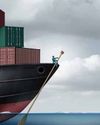يحاول ذهب - حر
SHAKEN AND STIRRED
May 2020
|Maritime Gateway
The COVID-19 pandemic has partially paralysed the logistics and supply chain, but the industry is still deterred to ensure supply of essentials continues
-

The world is witnessing an unprecedented crisis, but it has brought an unprecedented focus on logistics and supply chain. The financial, societal and business disruption has seen demand drop across the board, including at ports, trucking and shipping industry, almost anywhere you look. World Trade Organisation has predicted the world trade to fall by up to 32 per cent this year. CRISIL has drastically cut the GDP growth forecast for India for 2021 fiscal to 3.5 per cent from the earlier 5.2 per cent. But shipping and logistics is the lifeline to global consumers and as per directives from the Ministry of Shipping, Government of India, the port sector has been declared as essential services, for maintaining of supply chain link within the country.
There are serious concerns regarding the overall earnings of Indian shipping companies in the first quarter of 2020. There has been a sharp drop in the dry bulk cargo movement since the third week of January 2020. Indian port operators are experiencing a drop in cargo volumes since February start and no one is certain about turnaround time. Cargo movement at ports has seen a sharp drop of around 60 per cent in the last few weeks because of a huge fall in industrial production in the country. Ports across India are operating at capacities less than 30 per cent. The Centre’s move to waive demurrage charges during the lockdown is acting as a disincentive for importers to figure out ways to move cargo.
هذه القصة من طبعة May 2020 من Maritime Gateway.
اشترك في Magzter GOLD للوصول إلى آلاف القصص المتميزة المنسقة، وأكثر من 9000 مجلة وصحيفة.
هل أنت مشترك بالفعل؟ تسجيل الدخول
المزيد من القصص من Maritime Gateway

Maritime Gateway
Impact Of Covid-19 On Shipping And Logistics
Industry stalwarts discuss threadbare the prevailing logistics and supply chain scenario and issues in clearing cargo during the COVID-19 lockdown
15 mins
May 2020

Maritime Gateway
Digital Platforms Defy Lockdown
Digital trading modules such as eNAM are enabling farmers to move their produce from farm to market even during the lockdown
4 mins
May 2020

Maritime Gateway
GARMENT TRADE TRAMPLED
As retailers face a shutdown in US and Europe, the cascading affect has caused mass cancellation of orders in Bangladesh
2 mins
May 2020

Maritime Gateway
TRADE RESUMES WITH CHINA
While India has allowed uninterrupted movement of imports into Nepal even during lockdown, China is reopening its borders as it emerges from the pandemic
2 mins
May 2020
Maritime Gateway
LESS HUMAN INTENSIVE, MORE DATA DRIVEN
AI provides transformational opportunity for logistics industry by improving customer experience, operational efficiency, faster turnaround time and lower cost while ensuring security and transparency. Macro environment requires industry to transform to be less human intensive, agile and data driven, all of which can be accelerated by AI adoption, shares Gangadhar Gude, Founder & CEO, atai.ai
6 mins
May 2020

Maritime Gateway
SHAKEN AND STIRRED
The COVID-19 pandemic has partially paralysed the logistics and supply chain, but the industry is still deterred to ensure supply of essentials continues
9 mins
May 2020

Maritime Gateway
TRADE STUCK, ECONOMY SLOWS DOWN
Sri Lankan economy slows down as trade deficit widens and supply chain disrupts amidst lockdown
2 mins
May 2020

Maritime Gateway
LENDING INTELLIGENCE TO SUPPLY CHAIN
If you’re shipping millions of dollars’ worth of pharmaceuticals, high-end electronics, expensive seafood, or precious metals, what would you be willing to pay for the ability to ‘ask’ your shipment where it is right now and whether it’s ok? What would you pay for a freight smart enough to raise an alarm before it spoils? Artificial Intelligence enables that and much more…
15 mins
May 2020

Maritime Gateway
CONTAINER LINES SIGNAL ‘SOS'
As the per-unit cost of operations increases many lines are forced to blank sailings which has hit their bottom line real hard. The Government and Terminal Operators therefore need to actively consider reduction in Vessel Related Costs
2 mins
May 2020

Maritime Gateway
IMO 2020 And The Covid-19 Curse
The COVID-19 outbreak has shaken and stirred the already volatile bunker market. While the refiners adjust their capacities and shipping lines choose their path to compliance, the market dynamics are yet to reach an equilibrium
12 mins
April 2020
Translate
Change font size
